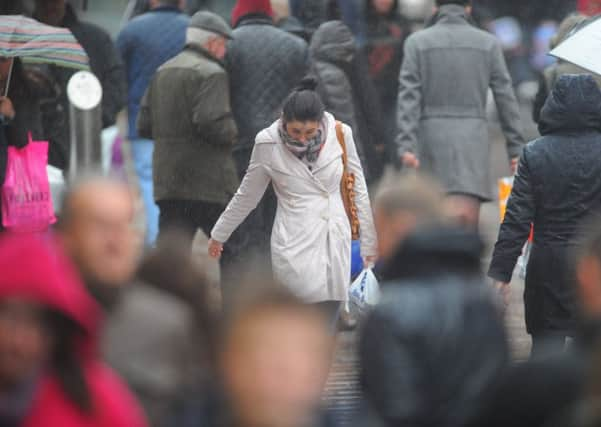Shoppers are hit in the pocket as sterling slumps
This article contains affiliate links. We may earn a small commission on items purchased through this article, but that does not affect our editorial judgement.


Yesterday’s news that consumer inflation had leapt to its highest level since September 2013 last month will have come as little surprise to the average shopper.
The slump in sterling has made itself felt through price hikes in everyday food items such as bread and vegetables, as well as non-essentials and “big-ticket” products including computer software, electrical goods and motor cars.
Advertisement
Hide AdAdvertisement
Hide Ad• READ MORE: Cost of living fears mount as inflation hits 2.3%
High Street price wars may have helped keep a lid on those increases, but food is now becoming more expensive as producers begin to pass down soaring import costs triggered by the pound’s weakness since June’s Brexit vote.
The latest official data revealed that overall food prices nudged up 0.8 per cent between January and February, in contrast to a smaller rise of 0.1 per cent a year earlier, after shock weather conditions in southern Europe ravaged crops and left supermarkets and restaurants grappling with a vegetable shortage.
According to the Office for National Statistics, the price of iceberg lettuce leapt 67.2 per cent between January and February after falling 0.8 per cent a year earlier.
A jump in transport costs also drove inflation higher, with motor fuels rising 1.2 per cent month-on-month in February. As a result, the price of petrol lifted by 1.6p per litre at the pumps to an average of 120.2p for February, while diesel increased by 1.3p to 123.2p over the period.
The net result is that the consumer price index (CPI) measure of inflation hit 2.3 per cent last month, higher than most economists had been expecting, and up from 1.8 per cent in January. As we close in on the end of March, there is every likelihood that figure will have headed further north by now.
Howard Archer, chief UK and European economist at forecasting consultancy IHS Global Insight, said the latest statistics make “uncomfortable news” for consumers, as well as the Bank of England, which has a long-term 2 per cent target on CPI.
He warned: “We expect consumer price inflation to trend markedly higher over the coming months as sterling weakness increasingly feeds through and overall higher oil and commodity prices impact.
Advertisement
Hide AdAdvertisement
Hide Ad“Additionally, several utility companies have announced electricity and/or gas price hikes in March/April. Specifically, inflation is seen rising to 3 per cent in late-2017 and peaking around 3.3 per cent early on in 2018.”
If there is a silver lining, then Archer believes that retailers, manufacturers and service providers will find the upside to their pricing power limited, given that the previous protracted squeeze on households’ purchasing power has made consumers “very price conscious”.
Inflationary pressures will stoke fears that interest rates could be on the rise. Kristen Forbes, one of the nine rate-setters on the monetary policy committee, broke ranks to vote for a quarter-point hike to 0.5 per cent last week amid fears that inflation is “rising quickly and was likely to remain above target for at least three years”.
The central bank, which will continue to use CPI as its measure for setting interest rates, predicted inflation to lift to 2 per cent in February, peak at 2.8 per cent in the first half of next year, and fall back to 2.4 per cent in three years – what some would now argue look like pretty optimistic forecasts.
Business leaders are concerned that inflation has become a key risk to UK growth prospects. The Centre for Economics and Business Research think-tank expects the inflationary squeeze on consumer spending power to lead to a slowdown in UK GDP growth from 1.8 per cent in 2016 to 1.6 per cent this year.
Suren Thiru, head of economics at the British Chambers of Commerce, believes that inflation will remain “persistently above” the Bank of England’s 2 per cent target over the near term, peaking at close to 3 per cent in the second half of 2018.
“The decline in the value of sterling, together with rising oil and other commodity prices, is likely to maintain the upward pressure on consumer prices in the coming months,” he noted.
Advertisement
Hide AdAdvertisement
Hide Ad“Rising inflation is a key risk to the UK’s growth prospects. Businesses continue to report that the rising cost of raw materials are squeezing margins, forcing many firms to raise their prices. Higher inflation is also likely to materially squeeze consumer spending in the coming months as price growth increasingly outpaces earnings growth.”
That spending power crunch is also highlighted by Calum Bennie, savings specialist at Scottish Friendly, who said: “If proof was needed that a squeeze is underway, this is it.
“With prices expected to rise further this year as a result of the fall in sterling, things will only get tougher for consumers whose wages are not rising sufficiently to keep pace. Shopping smarter or even cutting back spending are some of the ways we will cope while still trying to put money aside for the future.”